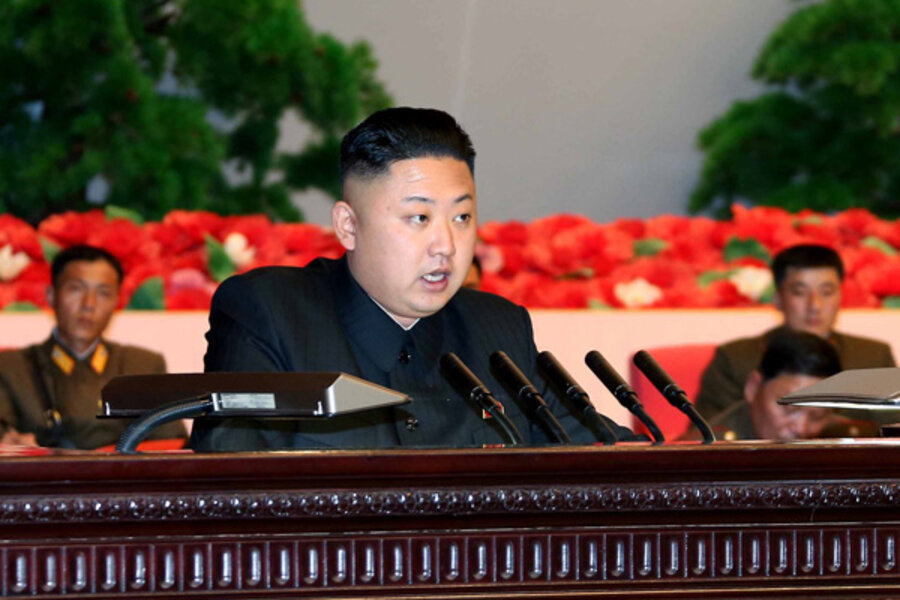North Korea: What happens if Kim Jong-un acts on his threats?
| Washington
Veteran North Korea watchers, citing what they see as increasingly troubling signs coming from the dictatorial regime, are voicing concerns that its new young leader, Kim Jong-un, could do something ill-advised, even start a war.
On Friday North Korea renewed what the U.S. has condemned as its “bellicose rhetoric,” saying Kim had ordered the nation’s missile forces to prepare to strike the United States and South Korea.
In response to the prospect of North Korea following through on this and other marginally less dire threats, Defense Secretary Chuck Hagel said Thursday that the US military “will unequivocally defend, and [is] unequivocally committed to the alliance with, South Korea.”
But if hostilities were in fact to erupt, how might they play out?
Some former US Special Operations Forces and longtime Korea defense analysts have their own thoughts on what an “unequivocal” US military response could look like, including how US troops would be deployed in the event of a lethal first strike on US and allied military forces by North Korea – precisely the sort of move Mr. Kim has been threatening to make.
What would such a first North Korean move resemble? It might involve small-scale infiltrations using mini-submarines, assassination attempts, “maybe shooting someone on the DMZ [demilitarized zone] or missile tests that fly too close over Japan,” says Patrick Cronin, senior director of the Asia-Pacific Security Program at the Center for a New American Security.
This might be done “to show he’s in charge, he won’t be intimidated, or because he’s truly desperate,” Dr. Cronin says.
In the past, most such provocations generally have been met with international condemnation and strengthened sanctions.
Should Kim choose to do “something even more outlandish,” the US military and South Korean response would be more dire, he adds.
One of the scenarios that most concerns US defense analysts, for example, involves North Korea’s estimated 500,000 to 700,000 rounds of artillery aimed at Seoul, says retired Brig. Gen. Russell Howard, former commander of the 1st Special Forces Group, which has an Asia focus.
Should Kim decide to begin firing them, he says, “in the first few hours of the conflict, it would be pretty ugly.”
At the same time, North Korea could begin “swarming” its sizable contingent of 600,000 Special Operations commandos, adds Mr. Howard, now the director of the Terrorism, Research, and Education Program at the Monterey Institute of International Studies.
The “sole purpose” of this group, he adds “is to infiltrate the South and create havoc.”
The realistic goal of the North Korean military would likely be to get some 150,000 of them over the border, where they would “go for infrastructure,” such as communications and transportation systems.
Complicating efforts to find these infiltrators would be a massive influx of North Korean refugees, in the neighborhood of 3.5 to 4 million into China and another 2.5 million likely moving south into South Korea.
“It’s going to be a human disaster that we’ve never experienced – there are going to be so many refugees,” Howard says. “It would just be a nightmare to try to separate civilians from the battlefield.”
Regular North Korea units might attempt to come across the border “with a huge burst of energy in the very beginning,” he says.
“But as the ammunition starts to run low, as food is low, with counterattacks, I have my own personal view that they would probably start to disintegrate within the first week,” Howard adds. “I’m not being flip when I say this, but it really depends on how hungry they are.”
Analysts suspect that the North Korean military is not particularly well-fed. Even though humanitarian rations meant for the North Korean population were once diverted to feed them, there are growing indications that this is no longer happening under Kim, Howard says.
The US military would immediately respond to the initial barrage of artillery with air power, using B-52s and highly-accurate B-2 stealth bombers to take them out, along with other key command-and-control targets.
But while the US would no doubt disable these systems, “the artillery or chemical weapons that North Korea is capable of firing into Seoul – a city of some 20 million – would still have a devastating impact,” says Victor Cha, the Korea chair at the Center for Strategic and International Studies in Washington.
“We would counter, but they could fire thousands of rounds of artillery first, before we could neutralize it. That has always been one of the problems,” he adds: While the North Korean military may not be particularly well-rounded or strong, it “can still do a terrible amount of damage.”
One key focus for the US and South Korean militaries would be psychological operations, which would be focused on trying “to dissuade the North Korean public from believing all this propaganda they’ve been hearing their whole lives.”
This, too, would be no small feat. This is true, for example, even among North Korean defectors.
“Even though they know they’re starving and it takes a lot of courage to defect, they are still hesitant to blame North Korean leadership,” Howard notes. “Often they are still more inclined to blame the West. North Korea is so isolated, the US is viewed as ‘the great Satan’ on steroids.”
Most difficult of all, perhaps, would be the mission that US Special Operations Forces would be given: There is little doubt that they would be deployed with an urgent order to secure North Korean weapons of mass destruction.
Accomplishing that “would be tough,” Howard says. “It would be very tough.”





